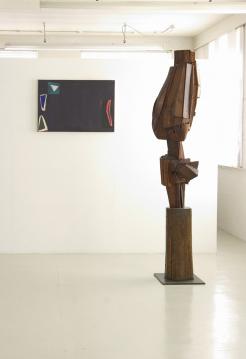15th January - 9th February 2008
Poussin Review 2008:
form and space
Douglas Abercrombie
Frank Bowling
Alan Gouk
Robin Greenwood
Peter Hide
John McLean
Mali Morris
John Panting
William Perehudoff
Fred Pollock
Tim Scott
Anne Smart
Peter Startup

Poussin Review 2008: form and space
Abstract painting and sculpture at this moment in time can not only be as simple or as complex as the imperative of the individual artist‘s sensibility demands, but is also able to pursue total formal and spatial freedom of expression. Paintings and sculptures which are impassioned by urgent and real formal and spatial values (but not a desiccated formalism!) have connections with and are comparable to all other such works. Making these comparisons is crucial to seeing art more objectively, but it also helps to open up new imaginative territory for ourselves. Making and looking at abstract art are neither disengaged nor esoteric activities; they connect us more securely with the real world. It is our intention in this ’Review’ to consider the flux and flow of visual structures as offered by abstract paintings and sculptures from the Sixties onwards, which have all in their various ways convinced us of their form. With the exception of the two very large sculptures illustrated, all the work in this catalogue will be exhibited at either the London Art Fair 2008, or at the exhibition at Poussin Gallery which follows. We continue like last year to emphasise the Seventies, which remains a favourite decade of ours, but we also have some new works to show, which offer a contemporary vision of form and space. Whenever they were made, these abstract paintings and sculptures retain their inherent formal and spatial values, which the artists have made implicit to their work. Poussin Gallery 2007 Modernism and abstraction have given rise to paintings and sculptures of great and grand simplicity, the best of which may nevertheless be thought of as continuing to embody the same complex structural realities of the physical world that we recognise in the great works of figurative art. Indeed, in order for abstract art to fully convince us of the ‘reality’ of its form, we may need to be subtly and unconsciously persuaded that it goes about its business by the same principles that we instinctively understand to pertain to the real world. To many people, abstraction denotes a pared-down geometry, or some kind of idealised absolutism. But what if the forms and relationships that the artist wants to pursue are more complicated and imaginative than that, even though abstract? They must at least be partially created before they can be conceived - somehow conjured out of the medium itself before any conscious recognition by the artist. This engagement with material simultaneously with, or even instead of, the formation of ideas, continues to be central to the methodology of abstraction. Lucid and simple abstract art can result from a protracted involvement with the complex issues of the artist’s chosen materials, under the sway of an intense imaginative effort. Such an engagement can achieve simplicity by the robustness of its form and the deftness with which our attentions are focused.
Modernism and abstraction have given rise to paintings and sculptures of great and grand simplicity, the best of which may nevertheless be thought of as continuing to embody the same complex structural realities of the physical world that we recognise in the great works of figurative art. Indeed, in order for abstract art to fully convince us of the ‘reality’ of its form, we may need to be subtly and unconsciously persuaded that it goes about its business by the same principles that we instinctively understand to pertain to the real world. To many people, abstraction denotes a pared-down geometry, or some kind of idealised absolutism. But what if the forms and relationships that the artist wants to pursue are more complicated and imaginative than that, even though abstract? They must at least be partially created before they can be conceived - somehow conjured out of the medium itself before any conscious recognition by the artist. This engagement with material simultaneously with, or even instead of, the formation of ideas, continues to be central to the methodology of abstraction. Lucid and simple abstract art can result from a protracted involvement with the complex issues of the artist’s chosen materials, under the sway of an intense imaginative effort. Such an engagement can achieve simplicity by the robustness of its form and the deftness with which our attentions are focused.